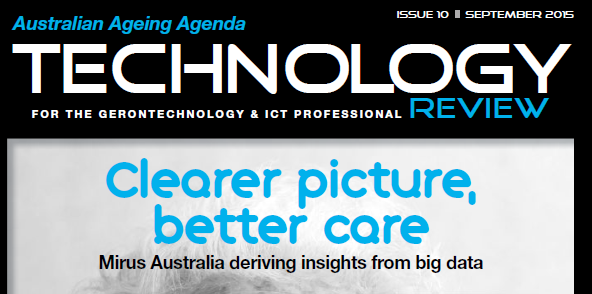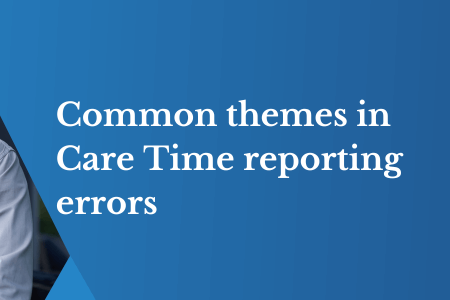Mirus Australia: Deriving insights from big data
October 26, 2015 | Aged Care Management

In the past 18 months Mirus Australia, a leading revenue management and advisory group for aged care providers, has delivered new solutions and advisory services to help providers keep up to date with the evolving nature of sector, as well as investing in innovations to up-skill a diverse workforce and deliver solutions for seniors. Kymberly Martin reports.
Mirus Australia is a company bringing innovation to the aged care industry. Already a leading industry player with its successful ACFI (Aged Care Funding Instrument) optimisation service, Mirus is expanding its offerings to provide a robust Aged Care Operating Model (ACOM) with an associated blended learning platform for aged care providers, as well as a wellness program with an improved focus on health and lifestyle for older Australians.
Recognising the need to deliver best practice across the industry, Mirus believes these new offerings will become vital resources for aged care businesses to support their workforce and embrace the principles of the government’s Living Longer Living Better reforms.
“As we enter an age where business is 24/7, wearable devices and remote monitoring is now increasingly accessible and customers demand for greater choice is stronger than ever, we must look to continually stretch the industry,” says Mirus Australia managing director James Price.
“The only way to achieve these consumer and industry demands is through innovation and up-skilling our people.”
ACTING ON INSIGHTS
When it comes to the ongoing management of accommodation charges, there is a huge amount of data available however deriving insights from that data can be a challenge. This is where Mirus uses its revenue management expertise and platform Mirus Metrics to help providers produce and act on these insights.
“The most critical aspect of this is the capital profile because not only do they have Refundable Accommodation Deposits (RADs) but also Daily Accommodation Payments (DAPs) and a combination thereof,” Price says. “It is critical to understand what type and combination of accommodation payment is required and how that relates to the strategy.
“There is no point in a provider asking for RADs and not using that money to build new facilities, improve facilities or pay down debt. They would be better off asking for DAPs, because that helps with cash flow, pays bills and wages, etc.
“This is often overlooked by some providers. Many don’t realise the impact on a case-bycase basis as to exactly what that means.”
As well as providing tools to manage individual admissions and pricing negotiations, Mirus is able to offer full transparency of pricing for rooms across the country through its Accommodation Pricing Report.
Having already helped clients in defining their strategy, Price recognises the current difficulties that providers face. “There are clients who recognise they have problems and need to deal with them and others who have yet to feel the pain that these changes bring. Aged care traditionally can be very much a case of waiting and reacting rather than a proactive approach to meeting these challenges. That is where the Mirus platforms and advisory service is unique. We look to educate our clients to be on the front foot and be prepared for what is ahead. It is when this happens, facilities will see significant increases in their bottom line and improved business processes”.
Price coins it ‘the brave new frontier’. Providers not only need to understand what competitors pricing looks like, but how their own cost model compares. “You don’t want to be a ‘5-star facility’ competing against a ‘3-star facility’ or viceversa. Often prices will be difficult to evaluate, so it is necessary to understand how RADs and DAPs can influence a resident’s ability
Mirus Australia helps aged care boards make strategic decisions through cutting-edge analysis to pay. Often this is not as straightforward as many people think.
“For frontline staff not trained in sales or negotiations, having these in-depth conversations with residents or families can be taxing. The risk is if those conversations are not managed well, both parties will have a less than satisfactory outcome. There is only so much advice frontline people can give to the family before they need to seek detailed advice from the professionals,” he says.
To make it easier for frontline staff to go through the admissions and accommodation process, Mirus has developed a set of analytical tools that help simplify the process.
ADAPT is a Mirus purpose built admissions tool which helps manage the sales and admissions pipeline. “We have created ADAPT so the chief financial officer can see, amongst other things, how many people came through the door, what they wanted to pay and where they came from and most importantly, how actuals compare to strategy. This information delivers a daily update from the frontline,” Price says.
“There is nothing worse than advertising a room for $300,000 and the frontline staff is processing an application for $200,000.By the time this is discovered it is often too late and the prospective client is probably very close to admission with the associated commercial arrangements near completion.
“The preferred scenario is that when the client comes through the door and offers $200,000 against a price of $300,000; it would be picked up by the management report on the same day. Admissions staff would be alerted and could then contact the client and their family to discuss options. It comes down to creating an offer that suits their means, and using Mirus ADAPT ensures a smoother pathway for the family or the provider to better match their expectations as early as possible,” he says.
LEARNING NEW BUSINESS SKILLS
As well as innovating and updating business processes, Mirus is finding new ways to engage and educate care staff.
“We acknowledge that systems are only as great as the people who use them, so up-skilling frontline staff is a key feature in capitalising every admission opportunity and meeting strategic business objectives “says Price.
With this in mind, Mirus has developed a curriculum that provides a comprehensive learning experience incorporating business and customer service skills. The idea came about when Price examined the operations of large organisations such as those in the hospitality industry.
“What we have in aged care is training in clinical skills but very little in the way of business skills that are recognised today. With the trend of a more consumer driven industry, there is an opportunity to build on this within the sector. We must now steer away from the mindset of being in the care industry as opposed to the care and service industry. Drawing from the hotels and hospitality industry model presents an opportunity as to how we can deliver better products and services in aged care.”
Mirus delivers this initiative through a blended learning program, starting with the admission process. “We have developed a blended learning model to merge key business processes in the aged care facility with universal customer service skills. Mirus is wellknown for its expertise in revenue processes and service, so we want to share these skill sets in online resources and support material,” says Price.
By introducing these skill sets, Price believes frontline staff will deliver greater results and strategic outcomes for facilities as well as higher levels of service for the consumer.
Care facilities will need to continue to be better skilled at running their businesses, and the only way to create sustainability around this is to invest and upskill people, Price says. “This is where we see our niche with our current solutions.”
He also uses the hotel reference when introducing the Mirus Aged Care Operating Model (ACOM). “Here is the front desk, laundry, café, concierge and a raft of business functions which are well documented. Everyone working in these areas knows exactly what their roles are, what their KPIs are, and know how these can be measured. There is a great opportunity in aged care to replicate a similar model to drive more consistency along with a greater understanding and visibility for everyone.
“Over the next 18 months our plan is to fine tune an efficient operating model for aged care, along the lines of successful established franchise business models in other markets.”
DELIVERING ON MARKET INTELLIGENCE
The company’s confidence in providing results is warranted – it currently provides daily ACFI benchmarking for providers against more than 50,000 beds and counting. Expanding on this success, Mirus continues to invest in new business intelligence platforms using new technology, especially when it comes to accommodation pricing.
“For a provider who is building or planning to build a facility, we can show them within a defined radius of their location, how many people are over 65, 75 and 85 years, their income and what their house is worth indicatively,” says Price. “We can then look at whether the proposal should include building a ‘5-star’ or ‘3-star’ facility at the right price. There may be little point in building a facility where rooms are priced at $750,000 when the median house price is $350,000 or vice versa.”
Price believes that no one else can supply this level of market intelligence and is what sets Mirus apart from competitors. “We deliver information that is relevant and current by giving a more detailed view of the landscape. This difference in our service is what makes our data just that much more valuable. Mirus has the technology, business intelligence databases, the analytics and people who understand the data and can translate this into information the clients can easily understand.”
Also ahead for Mirus is a foray into the wellness sector that has the potential to go into the broader aged care community. It is proposing looking at not just acute clinical indicators but also lifestyle opportunities. Price points to the growing popularity of wearable technology for monitoring how many steps we take, or food apps for checking on calorie intake and exercise programs. The question Mirus has been exploring is how we coordinate all this data, not just for the individual, but for families and health workers.
“If you take a step back and examine this from another angle, it’s about keeping people active and engaged, not just physically but mentally,” says Price. “By taking a holistic approach this can be managed in a number of ways. We envisage a structured data system comprising three key components – how to capture data, how to manage that data and how to convey insights from that data, delivered via a dashboard. This could include wearables although these gadgets have had mixed success with some restrictions, limited power being one of them. Room sensors may be a better option for detecting changes in client behaviour.”
Ultimately it comes down to reliability, usability and affordability and, as the prices of these devices fall and become a more mainstream commodity, these can be integrated into other systems, Price says. The next step is deciding who will be responsible for interpreting the data and communicating this information to the right people.
He argues that the ability to have data compiled with integrity is essential to supporting clients. “For example, if you are conveying this to the family where grandma has not moved out of her chair all day she might need to get involved in some activity. Basically what it does is give us an awareness into older people without being intrusive and getting lots of data points along the way that are reliably and consistently collected and managed to give us a better understanding into what is happening.”
Price concludes that, as the industry evolves, “it is clear that Mirus Australia will be at the forefront of change and innovation and deliver on its promise by #MakingAgedCareBetter for all involved.”


